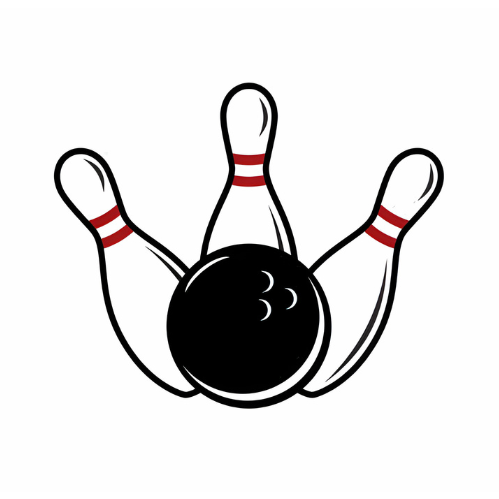The bowling ball oil track refers to the pattern of oil deposited on a bowling ball. This track affects the ball’s hook and overall lane behavior.
As a bowler steps onto the polished wooden floors of a bowling alley, they equip themselves with a bowling ball a spherical sporting implement, crucial for knocking down pins at the end of the lane. But there’s an invisible player in this game: the layer of oil that coats the lane, influencing each roll.
The ball, as it glides and spins down the lane, picks up this oil in a distinctive path or track. Understanding this track is essential for bowlers who aim to refine their technique, adjust their grip, and ultimately enhance their game. The oil track offers insights into the ball’s rotation and can highlight areas for performance improvement, making it a key consideration for serious competitors and enthusiasts alike.

Credit: www.bowlerx.com
The Hidden Role Of Oil In Bowling
Bowling enthusiasts often overlook the oil patterns on lanes. These invisible tracks play a huge part in the game. Oil on the lane creates different friction levels. This affects how the ball moves. A well-oiled lane lets the ball glide smoothly. A lane with less oil makes the ball hook sharply.
Expert bowlers study these oil tracks. They adjust their throws to match the oil pattern. Mastering oil patterns can lead to better scores. It’s like knowing the secret to a treasure map.
Understanding the impact of oil is crucial. It changes how the ball reacts to the lane’s surface. Without knowledge of oil, bowlers may blame their balls. But it’s really the oil dictating the ball’s journey.
Decoding The Oil Track: What Your Ball Tells You
Understanding your bowling ball’s oil track can greatly enhance your game. It is the visible path of oil that clings to your ball after a roll. This oil pattern gives hints on the lane’s condition and how your ball reacts. To spot the oil track, hold your ball up to a light source and look for a shiny ring that usually circles the ball. Keep the surface clean, as dirt can make it hard to read the track.
Analyzing the oil track can tell you about your throw. A track close to the holes suggests a straight throw. If the track is near the edge, it means more hook potential. The track’s thickness indicates the oil’s heaviness on the lanes. By reading these signs, you can adjust your swings and choose the right ball for the environment.
Matching The Ball To The Lane Conditions
Selecting the right coverstock for your bowling ball is essential. Different types of coverstock offer varied levels of friction on the lane. Reactive resin, urethane, and plastic are common materials. Each behaves differently on oily or dry lane conditions.
A reactive resin ball tends to create more friction, and therefore, more hook on an oily lane. On the other hand, a plastic ball works better on dry lanes due to less friction. Remembering this helps match the ball to varying conditions, thus optimizing your performance.
Understanding the oil pattern is crucial. The volume and type of oil on the lanes dictate ball choice. More oil calls for a ball with a stronger coverstock. Less oil is suited to a smoother coverstock. This knowledge lets you adapt effectively to the lane’s demands.
Tips And Tricks: Mastering Oil Track Adjustments
To master oil track adjustments, grasping strategic ball movements is crucial. Smooth arm swings and subtle wrist adjustments help guide the ball. This ensures accurate aiming along different oil patterns. Practice varying speeds and angles for diverse lane conditions.
Regular maintenance of your bowling ball is key. Clean the ball with a quality cleaner after each session. Wipe it down between throws to remove oil buildup. Schedule deep cleaning periodically. Use a microfiber towel to keep the surface in top condition. Proper care reduces oil track issues, maintaining consistent performance.
Advanced Techniques: Pro-level Insights
Every bowler knows oil patterns affect ball performance. Understanding oil conditions is crucial for success on the lanes. Different balls are designed for varied oil tracks. A polished ball tends to skid on heavy oil conditions. On drier lanes, a duller finish helps create more friction.
Pro bowlers maintain a diverse selection of balls. They choose the right equipment based on the type of oil pattern. A ball with a solid coverstock is perfect for thick oil. Conversely, a pearl coverstock works best for lighter oil conditions.
| Ball Type | Oil Condition |
|---|---|
| Solid Coverstock | Heavy Oil |
| Pearl Coverstock | Light Oil |
Pro players adjust their ball choices during competitions. They observe oil patterns shifting over time. A primary strategy includes starting with a stronger ball. They switch to balls that offer more control as lanes break down.
The Path To Consistency: Practice Makes Perfect
Mastering the oil track on a bowling ball is key for consistent performance. To improve, focus on drills and exercises specific to bowling.
- A focused practice regimen develops the skill to manage the oil track.
- Drills that enhance precision are vital for learning the correct path of the ball.
- Regular exercises can help in building muscle memory for repeated perfect throws.
By practicing the right movements consistently, bowlers can gain better control. This leads to better management of the ball’s oil track.
FAQ
What Type Of Oil Is Used On Bowling Lanes?
Bowling lanes typically use a special mineral oil or a synthetic blend designed for lane conditioning. This oil protects the lane surface and affects ball motion.
What Do Oil Rings On A Bowling Ball Mean?
Oil rings on a bowling ball indicate the lane’s oil pattern transfer after a roll. These marks show ball revolutions and help identify your bowling ball’s hook potential and oil track path.
What Is The Track In Bowling Ball?
The track on a bowling ball refers to the oil pattern created by the ball’s rolling path down the lane.
What Is Rule 31 In Bowling?
Rule 31 in bowling suggests leaving a gap of at least one lane between bowlers during non-competitive play to minimize distractions and promote courtesy.
Conclusion
Understanding the oil track on your bowling ball is crucial to optimizing performance. Keep it clean and adapt your game accordingly. With proper maintenance, you’ll notice a remarkable difference in your scores. Embrace the science of the sport for your best roll.
Good luck, and happy bowling!
